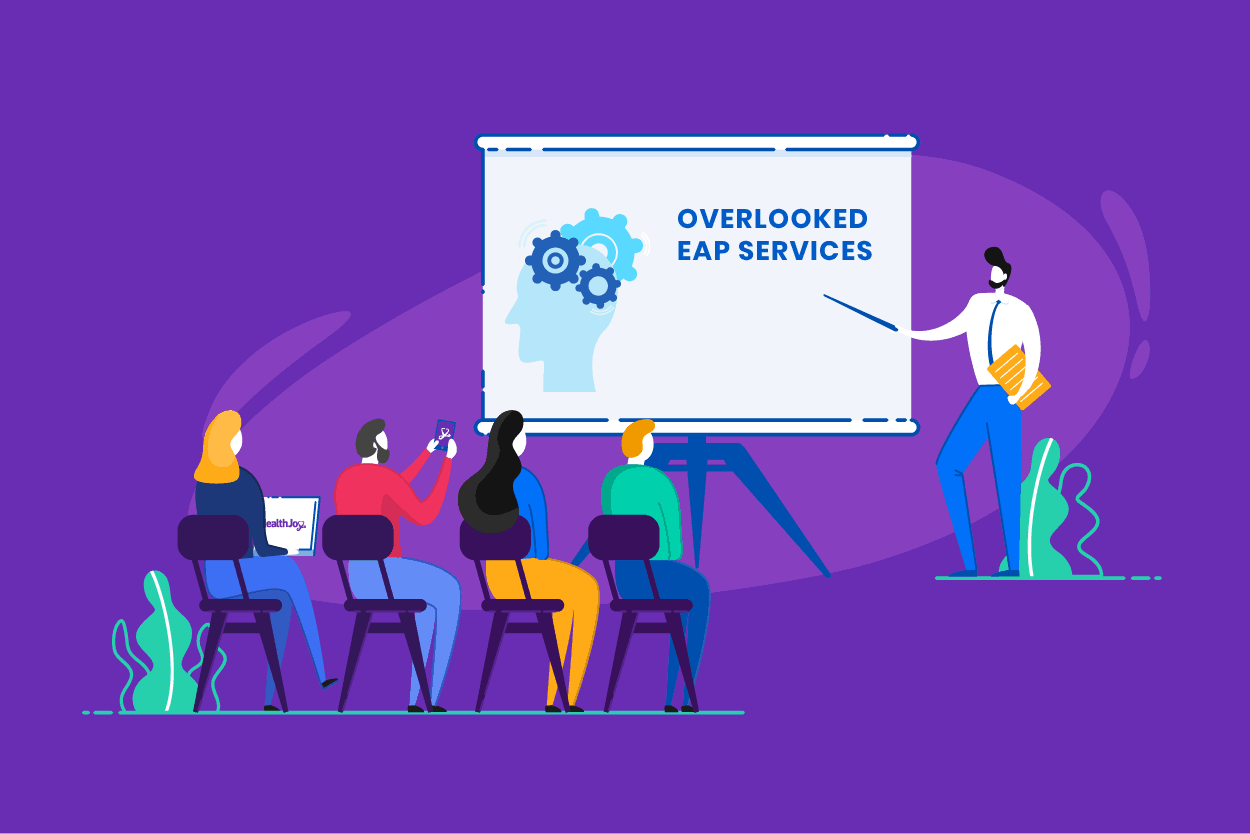The First Step in Handling Employee Substance Abuse
In the years since I began opening up about my own family’s struggle with substance abuse, I’ve found that nearly everyone I know has a similar...
Connected Navigation Platform
Guiding to high-value care
Behavioral Health
Foster a mentally healthy workplace
EAP
Supporting holistic wellbeing
Virtual MSK Care
Reimagining musculoskeletal care
Virtual Primary Care
Powered by smart navigation
Surgery Centers of Excellence
Best-in-class surgical outcomes
Virtual Urgent Care
Immediate care, any hour of the day
Chronic Care
A new approach to chronic care
Integrations
Flexible to any strategy

On average, organizations spend over $15,000 per year on each employee experiencing mental health issues. Employers are constantly searching for mental health services to support employees in a complete, cost-friendly manner.
Thankfully, an employee assistance program (EAP) can be a great option to provide support, combat workplace stress, and promote employee wellness. This not only helps with morale and wellbeing, it helps with your bottom line. According to the World Health Organization, every $1 organizations put into mental health programs, they get $4 back in increased productivity and better health outcomes.
EAPs fill in the gaps when employees are navigating through challenging life situations that affect both their personal and professional lives. And while EAPs boast many benefits, employees rarely take advantage of them.
In this post, we’ll look at why EAPs are often underutilized and share tips on what you can do to improve adoption and strengthen employee wellness.
An EAP can offer services employees and their families deal with a wide-array of issues including: relationship struggles, legal challenges, traumatic events, substance abuse, and financial concerns.
Studies show EAP services are a great way to increase employee productivity, happiness, and wellness. They deliver a $6.47 return on investment for every $1 spent.
Additionally, Employee Benefits News reports that the average EAP counseling participant had “63 hours of lost productive time during the month before the start of counseling.” After EAP counseling services, productivity had been restored by more than three full workdays per month.
It’s no wonder why they’re so common for US businesses looking to bolster employee well being, improve employee engagement, and combat employee turnover.
Percentage of Companies that offer EAPs (by size)
5,000+ employees: 97%
1,001-5,000 employees: 80%
251–1,000 employees: 75%
Despite their prominence, EAP utilization rates remain incredibly low. The National Business Group on Health found median utilization of EAPs is roughly 5.5%.
Let’s examine a few reasons your employees and their family members may not be taking advantage of this great resource.
1. LACK OF PROGRAM EDUCATION
If you’ve never heard of an EAP before reading this post, you’re not alone. EAPs suffer from a lack of awareness among the general population. As a result, employees who aren’t familiar are less likely to use the service.
Here are a few tips to better inform employees about this benefit:
If you’re thinking about introducing an EAP at your company, give employees a heads up ahead of time. You can host webinars or lunch-and-learns about the program and give everyone a sense of the support services that will be available.
The presentation should focus on topics that resonate with your employees. You could include ways EAPs help with: mental health management, elder care, loss of a family member, or legal issues.
Proactively providing materials with answers to FAQs can help lessen the burden on your HR team. Employees can return to this resource before and after your EAP launches.
EAPs generally have an awareness problem. Even when an employer offers an EAP, most employees don’t know it exists. Consider the following to bolster awareness:
Don’t just lump the program in with your wellness benefit information in your open enrollment materials. Instead, explicitly state that your company has an EAP. Then explain what assistance programs are available.
Just as you would with other benefits, be sure to promote the EAP throughout the year, not just during open enrollment season. That way, this employee resource can stay top-of-mind.
Most managers are in the same boat as other employees: They don’t know that EAPs exist. However, if you create opportunities for company leaders to get familiar with the benefits, they can serve as internal advocates for the program. This can play a significant role in raising overall awareness among employees.
Another barrier to using EAPs is a general misconception or misunderstanding that employees have around surrounding costs. Since many EAP services are similar to services employees associate with healthcare, they might assume they’re responsible for a copay or deductible.
This misconception could deter employees from seeking much-needed support, which can lead to a worsening of their situation. Be sure to reiterate that EAP counseling sessions are free to employees and are entirely covered by the employer.
You can clarify cost concerns by:
Keeping your EAP separate from your health insurance in internal communications, like your benefits booklet, makes it clear there aren’t any costs associated with this program.
EAP counselors are equipped to deal with categories of problems that many health plans don’t cover. Emphasize that EAPs are a great and convenient alternative to seeking expensive providers outside the program.
Convenience is key. So if your benefits information is scattered across multiple places, employees are unlikely to use it. Combat disorganization by making resources easily accessible in one location.
Picking the right vendor is another crucial step for success with EAPs. Select a vendor that can easily integrate with your existing portals. Also, look for a user-friendly interface that won’t be difficult for your HR team to manage.
An EAP can be a remarkable tool for your employees, and when your employees feel supported, everybody wins. According to Forbes, “happy employees are up to 20% more productive than unhappy employees.”
Investing in a few steps to start — like educational sessions and easy-to-digest materials — can lead to a serious uptick in usage. As a result, you’ll have employees who feel empowered to better manage their personal and professional lives.
Here are a few ways to learn more about how HealthJoy can help your organization centralize mental health offerings:
Webinar: Championing Mental Health in the Workplace
This post was published in March 2022. It was updated June 2023.
In the years since I began opening up about my own family’s struggle with substance abuse, I’ve found that nearly everyone I know has a similar...

When you think of supporting employee mental health through a pandemic, a counseling benefit might be the first thing that comes to mind. But what...